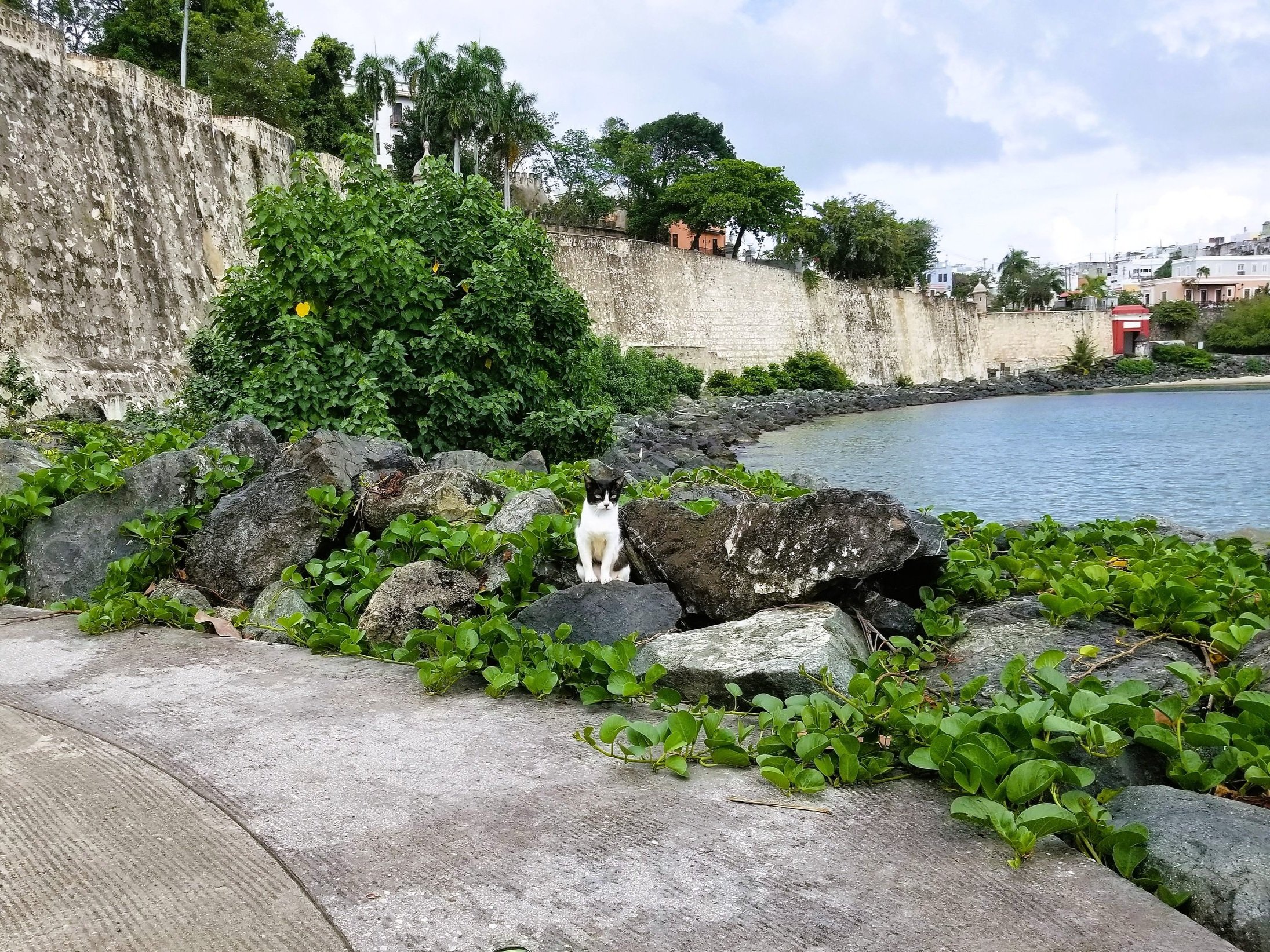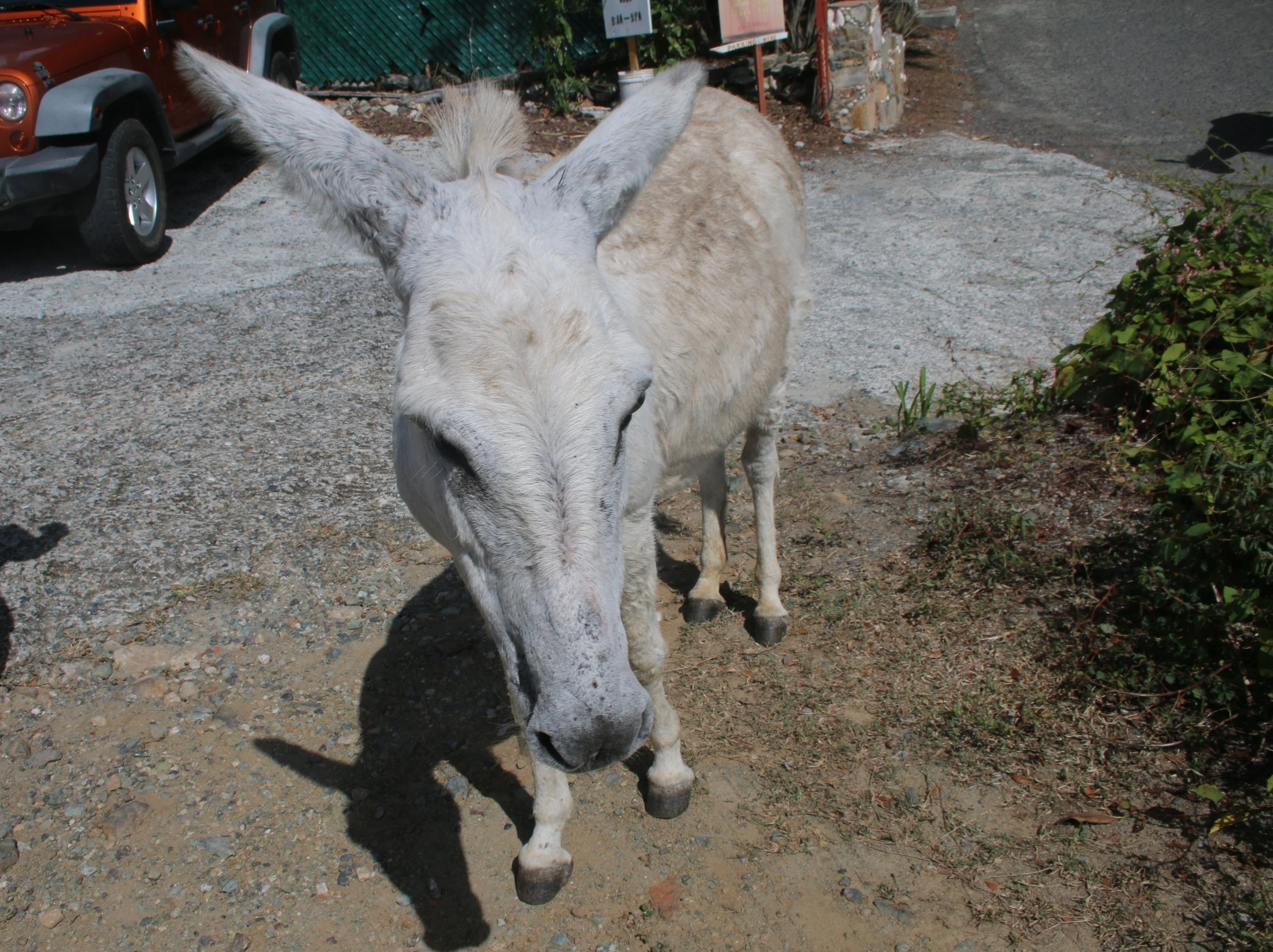Puerto Rico's Save a Gato protects Old San Juan's living history - its cats
Because they matter
People walking along the Paseo del Morro around Old San Juan give us strange looks as we buzz by in an old golf cart. Those looks don’t bother my driver Karla Colom as she navigates the winding paved path squeezed between Bahia San Juan and the walled cliffs holding up the historic Spanish fortress of El Morro. Originally build in the 1630s, Colom searches for the paseo’s only permanent residents – cats. Coming upon some shrubs lining the path, Colom hits the brakes and begins calling names.
Vladimir! Payona! Simba and Mufasa! Ramon! Pico! Hey, Gizmo! Julio!
Karla Colom draws out the cats of Paseo del Morro with a can of cat food. Photo by Carrie Dow.
While I didn’t see any cats as we drove by, there are now dozens of them – all sizes and colors – running, walking, and sauntering up to us. Colom opens one of the cat food cans she brought and a few cats who hung back, wary of the stranger Colom brought with her, came sprinting.
“The power of the can compels them,” she laughs plopping spoonfuls of wet cat food along the paseo’s retaining wall.
Colom is a long-time volunteer for Save a Gato, an organization overseeing the cats who live freely around El Morro. While Volunteer Coordinator is her official title, Colom wears many hats, including caretaker for this large section around one of San Juan’s National Historic Sites. She gets up early in the morning twice a week to feed and check on the hundred or so cats who live here. She also organizes and trains volunteers for the other days of the week and educates the public on why these free roaming – but not wild – cats are important to Old San Juan.
“There’s a lot of people that come to Puerto Rico looking for the cats of Old San Juan,” she says squinting in the bright afternoon sun. “When people approach us in Paseo del Morro, I always tell them the story. Some cats have been there longer than the paseo.”
The cats greet Save a Gato’s golf cart. Photo by Carrie Dow.
Cats have lived in Old San Juan since the Spanish brought them on their galleons in the 1500s, when they took the island of Puerto Rico for Spain. Cats not only controlled rodents on ships, but sailors thought they brought good fortune and were brought ashore to do the same. It is believed that most of Puerto Rico’s cats are descendants of those original Spanish felines. The cats did their mousing job so well over the centuries, San Juan has few rats today. Unfortunately, there are way too many cats. Keeping the local population healthy and under control is a major part of Save a Gato’s mission.
As Colom introduces me to the paseo cats, a couple with two young children approach. The man asks her a question in Spanish as the kids pet one of the cats. Colom answers emphatically in Spanish, talking to the family for almost five minutes.
“I’m sorry,” she says returning to me, “but when Puerto Ricans stop and ask me questions, I love that. I take my time to explain to them the importance of a controlled colony in an urban area. They were like wow. Education is the key.”
Colom stresses that Save a Gato is not an animal shelter. While they have a building and some cats are available for adoption, they are not a rescue because these cats already have a home. The organization provides healthy food, medical care, vaccines, and lots of love to these cats. That’s why Colom insists every cat on the Paseo del Morro has a name and she knows them all.
The cats enjoying extra treats on the Paseo del Morro. Photo by Carrie Dow.
“The funny thing is the first week I’m there, I’m asking about the names of the cats,” Colom explains while describing her first week on the job. “They’re like, some of them have names, but most of them don’t. I’m like why? Well, because they live out here. I’m like wait a minute. Why did your parents give you a name? Because you mattered. Because you are someone. And they matter. So, I started giving them names.” Today, all cats are named, numbered, and neutered with written records including photographs kept by the organization. They know when cats go missing and when new ones arrive.
There are seven feeding stations along the Paseo del Morro and different cats “live” at different stations. Station 2 where we are now is the most populated. After emptying the can, she motions for me to follow her behind the bushes and up a small hill. At the top are large plastic tubs converted into feeding stations. Because the food is outdoors, they have modified the tubs to protect the food from insects. The bottom is filled with soapy water and the food and water bowls are set in the middle with the tub or lid covering the bowls. The soapy water acts as a moat keeping ants and other insects at bay. The boxes have openings cut into them so multiple cats can access the food inside. Colom says they feed and change the water every day and they clean the stations every few days. It’s a big job she says because they must haul large jugs of water with them since there’s no potable water along the trail.
Some of the feeding boxes along the Paseo. Photo by Carrie Dow.
Also on the hill, but away from the feeding boxes, Colom points to two mats covered in sand. This is where the cats poop and pee, like a giant litter box. Colom says they want the cats to have a safe place that is out of sight to do their business and it accomplishes two goals. It keeps the cats from doing their business around the path, which would be not only unsightly and stinky, but a health hazard. It also makes it easier for the volunteers to clean the area. She says they haul out the waste and replace it with fresh sand. The sand naturally attracts the cats to the area to do their business.
After the cats of Station 2 have finished the canned food, we hop back in the cart and head to the next station. It’s around a tight corner on the golf cart, but Colom has driven the path so many times, she could do it blindfolded. Station 3 is smaller and the food boxes are behind a large electrical/mechanical box. Colom stops the cart and begins calling names again, but I don’t see a single cat. I ask her where they are.
“They’re right here,” she says pointing the rocks holding back the sea. I don’t see a cat at first, but then I see movement. A brown tabby jumps from rock to rock to reach us. Then I see a tortoiseshell on another rock, and a black and white cat almost invisible except for a wavy tail on a grey rock. The cats hide in plain sight. Colon adds that although it’s hot in the sun, the cats stay cool by hiding under the rocks. While the sun heats up the top of the rocks, rocks don’t conduct heat, so the underside stays cool.
Students from the local art school painted murals on the Casita. Photo by Carrie Dow.
As Colom drives the paseo, she explains they do adopt out some cats, but under special circumstances. Unfortunately, Colon says many San Juan residents believe that any cat can live on the paseo and will dump their unwanted cats and kitten litters in the area. Residents falsely believe that their former house cats will be fine because Save a Gato will care for them, but often these cats – having never lived on their own before – are susceptible to diseases, can get injured by resident cats or area wildlife, or get hit by cars on Old San Juan’s crowded streets. Because Save a Gato track all the cats, they know immediately when an outside cat has been introduced and will collect those cats for adoption. Adoptable cats are kept at local PetSmart and Petco stores. Colom adds it is a $1000 fine for anyone getting caught releasing a pet cat into the area.
After touring the paseo’s feeding stations, we return to the Casita, an old, abandoned cement building they use as their home base and care center. The cart must travel through the historic Spanish Gate and up a steep side street to get back to the Casita, which is tucked under large, shady trees next to a playground and tennis courts. The playground is called Parque Pasivo Viejo San Juan, but if you look it up on Google Maps, the area also will say Parque de los Gatos, aka Cat Park. As we park in the cart’s designated spot, several cats that had been laying in the grass around the building come over. After telling me their names, she takes me inside the building, which they dubbed the Casita after the home in the Disney movie Encanto.
“The house in the movie is a magical house,” she explains. “This place we call Casita because it’s filled with love and magic.”
The door has two small holes cut into the bottom to let cats in and out because they keep food and water available in and around the building. Not only is the building for supply storage, it is also a medical clinic where sick cats and momma cats with kittens stay until they can be re-released. Most of the sick cats have skin or eye issues requiring daily drops and salves. Anything more serious would go to a vet. There was one momma cat, a black and white named Oreo, with a litter of six black and white babies. The babies mew at Colom and nuzzle the fingers she sticks into the cage as she talks to them.
Colom knows the name and story of every cat on the paseo. Photo by Carrie Dow.
Everything they have, Colom says, is donated or purchased with donated funds because Save a Gato relies solely on public donations. While they receive no city funds, San Juan did donate the building and the city pays its utilities (which sounds awesome until Colom mentions the building has no toilet). Although the cats live on National Park Service land – the fortress of Castillo San Felipe del Morro is a National Historic Site – the park service doesn’t provide any help either. If fact, Colom says the park service prefers the cats weren’t there at all believing them a nuisance. However, Colom argues the cats are famous. The hundreds of cruise ship passengers who disembark daily from the nearby port terminal to tour Old San Juan often ask to see the cats. Photos of “The cats of Old San Juan” can be found all over social media. Colom would like to put up a ‘cat cam’ so people can follow the cats on their website, but it is a low priority on her wish list.
Instead Colom wishes people, especially San Juan residents, would appreciate the cats not only for the benefits they provide, but for their beauty, historic importance, and general feline adorableness. If you find yourself exploring El Morro in Old San Juan, take some time to appreciate, and maybe take a selfie with, those beautiful cats. And if you see Colom on the trail, say ‘hola’ and ask her about the cats. She’ll introduce them by name to you too.
Save a Gato is always in need of volunteers, but you must be resident of San Juan to work directly with the cats. Visitors are encouraged to donate funds either online or in the drop box at the Casita.













